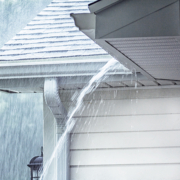Removal and Prevention of Ice Dams

Ice dams are ridges of ice that can form on the overhangs or valleys of a roof. In cold weather climates, ice dams can occur after heavy snowfall. When a roof warms up, snow can melt and cause water to run down the roof. When melting water hits ice that has already formed, it creates what are known as ice dams.
In general, anything that prevents water from evacuating a roof presents the potential for problems. But if left for a period of time, pooled water can accumulate around and under shingles. Once water penetrates a roof deck, interior damage can occur.
Why Ice Dams Should Be Removed
Ice dams can cause damage to roof shingles and gutters. Backed-up water can then leak into your home. Ceilings can sag, sheetrock walls can warp, and floors can be damaged or stained. It is recommended that you inspect your roof in the days following each heavy snowfall. If you observe any ice dams forming, take the steps below to remove them as soon as possible.
How to Remove An Ice Dam
Chipping away at ice dams with a shovel or hammer is not recommended. These tools are too short and too heavy, and they require the use of a ladder during icy winter weather. Avoiding climbing on ladders during winter is recommended for safety reasons. Additionally, a heavy-handed blow from a tool can inadvertently cause damage to shingles or gutters.
Instead, try using a long-handled aluminum rake to remove your ice dam, and remain on stable footing on the ground. Carefully work away at the dam as much as you can. If you find you cannot reach the entire dam, it is best to call a reputable, full-service gutter company such as The Gutter Specialist to expertly remove your ice dams.
How to Prevent Ice Dams From Recurring
If you find that an area of your roof tends to form ice dams repeatedly, look at ways to prevent recurrence. In general, roofs that remain relatively the same temperature as their eaves (the underside) are far less likely to build ice dams. The goal is to prevent the eaves of your roof from getting too warm.
You can keep roof temperatures relatively the same by taking the following steps:
Increase Ventilation
Add Insulation
Seal Air Leaks
Add Flashing Around Chimneys
Seal and Insulate Ducts
By making sure all of the above conditions are in place in and around your home, you will go a long way toward preventing future ice dam buildup on your roof.



